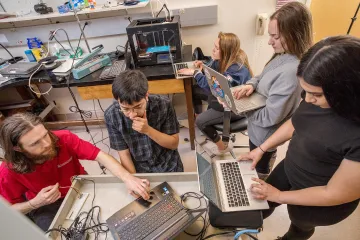Gift Equips Engineering Students to Build Lifesaving Technology

UA engineering students fine-tune their virtual reality system for CPR training after hours on the floor of a lab at the Sarver Heart Center.
Biomedical engineering students at the University of Arizona will soon have the chance to solve hands-on design challenges in all four years of their engineering studies.
Peter Salter ’65 and his wife, Nancy, made a $1.5 million gift for a new biomedical device lab and course development. Starting next spring, third-year students will conduct hands-on design, including construction of medical devices, in a purpose-built makerspace.
“This is an area that is developing very quickly,” Peter Salter says. “I want to see the University of Arizona be a leader in this area of medical device product development in regard to engineering.”
Salter founded medical device company Salter Labs in 1976. Today, it’s a leading global manufacturer of respiratory products for both hospitals and home care.
The Salters’ gift “is a significant contribution to a unique laboratory and course that will serve as an example in academia,” says Larry Head, interim dean of the College of Engineering. “Not only will this laboratory play a role in advancing life-changing — and lifesaving — technology, but it will help prepare students to be future leaders in biomedical engineering.”
Associate professor Urs Utzinger and assistant professor Philipp Gutruf are developing the course with help from their colleagues.

A new purpose-built makerspace will allow many engineering students a roomier place to create.
“The [biomedical engineering] faculty is excited about contributing ideas for learning modules that will highlight emerging technologies and innovative biomedical applications. I think the students will be even more excited when they see what we have in store for them in this class,” says Art Gmitro, head of the department.
And, Gmitro says, the Salters’ generosity has laid a foundation that goes beyond the new course.
“This gift is really transformative in terms of the infrastructure it will build but also in the conceptualizing of what we want to do for improving education,” he says.
The Salter’s gift furthers the college’s emphasis on collaborative, experiential learning, allowing students to work together in a laboratory environment and to learn by doing.
Currently, all engineering undergraduates design and test solar ovens as freshmen and complete ambitious design projects as seniors. Sophomores studying biomedical engineering build machines to sort Skittles candies by color. The new class bridges the gap, creating a four-year design experience.
One of the keys to preparing students to excel in the rapidly changing field of biomedical engineering is to give them more open-ended problems to work with, says Gmitro.
“You go into a typical classroom and there’s a solution, and you either get it right or you get it wrong. But when you’re actually designing and building something that doesn’t exist, there isn’t just one solution; nobody knows the answer. We’re trying to build that adaptability into the department.”
Peter Dawson is a graduate student who has assisted with teaching the class in which students build Skittles sorters.
“It’s almost impossible to start picking up these advanced concepts without ever having built something,” he says. “They’re designing this structure so students can leave feeling confident in their abilities as engineers, not just in theory but in practical application. One week in the lab might be worth four weeks of lecturing, in terms of what you end up learning.”
